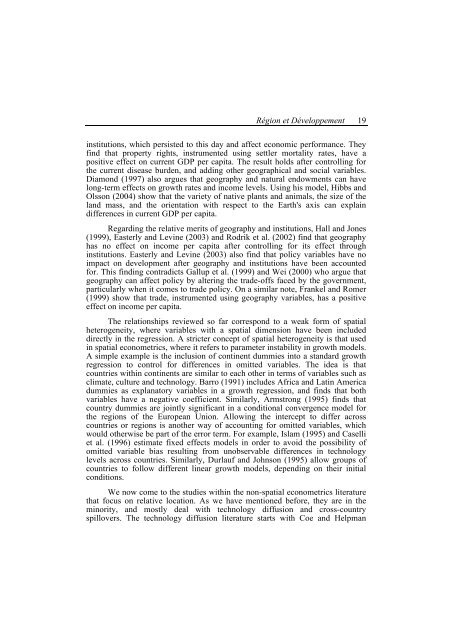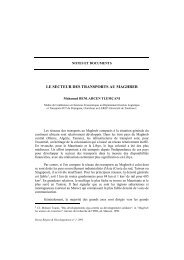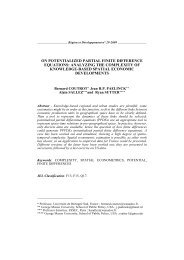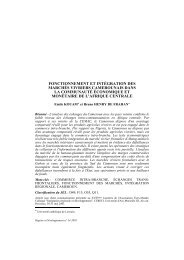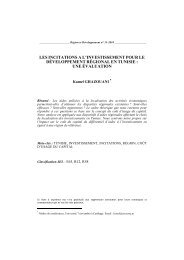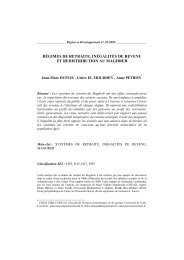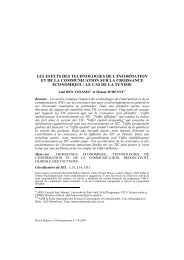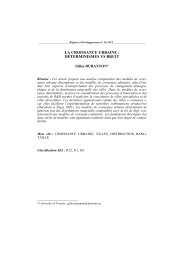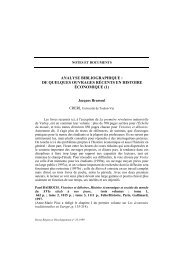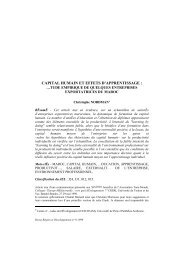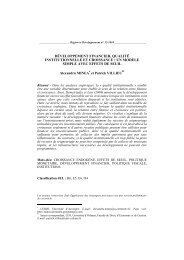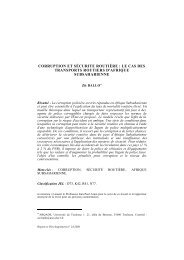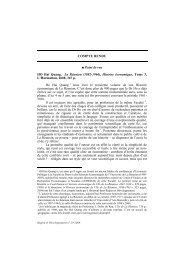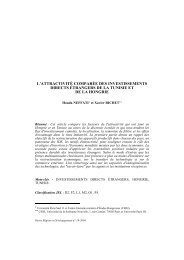space and growth: a survey of empirical evidence ... - ResearchGate
space and growth: a survey of empirical evidence ... - ResearchGate
space and growth: a survey of empirical evidence ... - ResearchGate
You also want an ePaper? Increase the reach of your titles
YUMPU automatically turns print PDFs into web optimized ePapers that Google loves.
Région et Développement 19institutions, which persisted to this day <strong>and</strong> affect economic performance. Theyfind that property rights, instrumented using settler mortality rates, have apositive effect on current GDP per capita. The result holds after controlling forthe current disease burden, <strong>and</strong> adding other geographical <strong>and</strong> social variables.Diamond (1997) also argues that geography <strong>and</strong> natural endowments can havelong-term effects on <strong>growth</strong> rates <strong>and</strong> income levels. Using his model, Hibbs <strong>and</strong>Olsson (2004) show that the variety <strong>of</strong> native plants <strong>and</strong> animals, the size <strong>of</strong> thel<strong>and</strong> mass, <strong>and</strong> the orientation with respect to the Earth's axis can explaindifferences in current GDP per capita.Regarding the relative merits <strong>of</strong> geography <strong>and</strong> institutions, Hall <strong>and</strong> Jones(1999), Easterly <strong>and</strong> Levine (2003) <strong>and</strong> Rodrik et al. (2002) find that geographyhas no effect on income per capita after controlling for its effect throughinstitutions. Easterly <strong>and</strong> Levine (2003) also find that policy variables have noimpact on development after geography <strong>and</strong> institutions have been accountedfor. This finding contradicts Gallup et al. (1999) <strong>and</strong> Wei (2000) who argue thatgeography can affect policy by altering the trade-<strong>of</strong>fs faced by the government,particularly when it comes to trade policy. On a similar note, Frankel <strong>and</strong> Romer(1999) show that trade, instrumented using geography variables, has a positiveeffect on income per capita.The relationships reviewed so far correspond to a weak form <strong>of</strong> spatialheterogeneity, where variables with a spatial dimension have been includeddirectly in the regression. A stricter concept <strong>of</strong> spatial heterogeneity is that usedin spatial econometrics, where it refers to parameter instability in <strong>growth</strong> models.A simple example is the inclusion <strong>of</strong> continent dummies into a st<strong>and</strong>ard <strong>growth</strong>regression to control for differences in omitted variables. The idea is thatcountries within continents are similar to each other in terms <strong>of</strong> variables such asclimate, culture <strong>and</strong> technology. Barro (1991) includes Africa <strong>and</strong> Latin Americadummies as explanatory variables in a <strong>growth</strong> regression, <strong>and</strong> finds that bothvariables have a negative coefficient. Similarly, Armstrong (1995) finds thatcountry dummies are jointly significant in a conditional convergence model forthe regions <strong>of</strong> the European Union. Allowing the intercept to differ acrosscountries or regions is another way <strong>of</strong> accounting for omitted variables, whichwould otherwise be part <strong>of</strong> the error term. For example, Islam (1995) <strong>and</strong> Caselliet al. (1996) estimate fixed effects models in order to avoid the possibility <strong>of</strong>omitted variable bias resulting from unobservable differences in technologylevels across countries. Similarly, Durlauf <strong>and</strong> Johnson (1995) allow groups <strong>of</strong>countries to follow different linear <strong>growth</strong> models, depending on their initialconditions.We now come to the studies within the non-spatial econometrics literaturethat focus on relative location. As we have mentioned before, they are in theminority, <strong>and</strong> mostly deal with technology diffusion <strong>and</strong> cross-countryspillovers. The technology diffusion literature starts with Coe <strong>and</strong> Helpman


